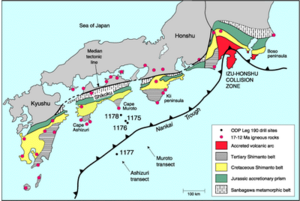Earthquake early warningJapan boasts an earthquake early-warning system, but critics question its value
Since 1979, scientists with the Japanese earthquake prediction program have been monitoring a stretch of coastline southwest of Tokyo, watching for ground motion which might signal a pending rupture on the nearby fault zone. If motion is detected, Japanese law requires the prime minister to issue an emergency warning to close schools, secure hospitals, and shut down critical public transportation systems. Critics argue Japan will be unable to predict earthquakes in the same manner meteorologists track approaching typhoons or rain storms, saying that the program offers false hope.

Potential earthquake zones based on detritus accretion // Source: tamu.edu
Since 1979, scientists with the Japanese earthquake prediction program have been monitoring a stretch of coastline southwest of Tokyo, watching for ground motion which might signal a pending rupture on the nearby fault zone. If motion is detected, Japanese law requires the prime minister to issue an emergency warning to close schools, secure hospitals, and shut down critical public transportation systems. Critics argue Japan will be unable to predict earthquakes in the same manner meteorologists track approaching typhoons or rain storms, adding that the program gives false hope.
The Pacific Northwest is subject to the same type of high magnitude earthquake Japan hopes to predict, but many U.S. and some Japanese experts are convinced that earthquake prediction is impossible. “Earthquake prediction is very, very difficult — maybe impossible,” said University of Tokyo seismologist Kazushige Obara, a member of Japan’s Coordinating Committee for Earthquake Prediction. “But it’s the ultimate goal of our research, which is why we keep the name.”
According to Emergency Management, Japan’s prediction program assumes that an earthquake will be preceded by “preslip,” a precursory fault motion significant enough to force a portion of coastline to bulge rapidly. The only evidence that this might happen comes from leveling surveys following Japan’s deadly 1944 earthquake. “It beggars belief … that the Japanese government operates a legally binding earthquake-prediction system on this basis,” University of Tokyo seismologist Robert Geller wrote in a 2011 commentary in the journal Nature. “Such claims have been made for over 100 years and all have proved false,” he added.
Supporters of the program point out that days before the 2011 Tohoku quake and tsunami, seafloor monitoring instruments showed that the offshore fault for that quake was slipping slowly. A similar slip preceded a quake on an offshore fault in Chile. This observation led earthquake experts Emily Brodsky and Thorne Lay of the University of California, Santa Cruz to suggest that better monitoring of the seafloor might someday help find better detectors of pending earthquakes. “Whether earthquakes are predictable or not is still an open question,” Brodsky and Lay wrote in the journal Science, “but perhaps there is now some cause for optimism.”
Even if earthquakes are presently unpredictable, some scientists are looking to sharing detection data with the public. “I think we’re close to a working forecast system,” said Tom Jordan, director of the Southern California Earthquake Center. Japan, the United States, and dozens of other countries are testing more than 400 earthquake-forecasting models to give way to better earthquake monitoring systems.
Today, Japan’s billion-dollar earthquake early-warning system uses the detection of primary waves (P-waves), which comes before the destructive S-waves, to alert residents ten seconds to a few minutes before an incoming quake. A prototype system in California is already being used by the Bay Area Rapid Transit System and researchers. Dubbed ShakeAlert, the system notified test subscribers of the recent magnitude-6 quake before it struck NAPA on 24 August. ShakeAlert researchers are asking Congress to provide the $120 million it would take to operate the program throughout California and the Pacific Northwest for the first five years.
If Japan is unable to predict an earthquake, perhaps a few minutes of warning is the next best thing, in which case, Japan already operates the most advanced alert system.
